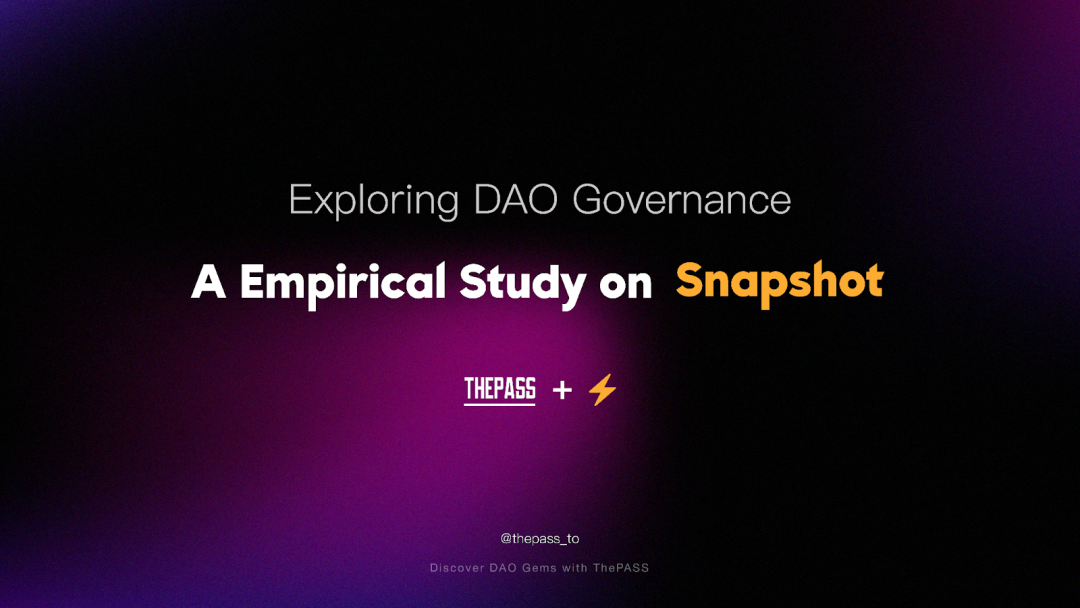
This research article is presented by TheLianGuaiSS team, and we have proofread the feems from Snapshot. We sincerely thank them. TheLianGuaiSS is a pioneering DAO aggregator and search engine that plays a key role in providing insights and analysis for DAOs.
Intro
Due to the distrust of centralized financial institutions, Crypto builds a trustless digital infrastructure outside the traditional world using mechanisms such as blockchain, cryptography, consensus protocols, and smart contracts. In addition to innovative applications such as DeFi, NFT, GameFi, this decentralized infrastructure has also realized a new type of organizational collaboration model called DAO (Decentralized Autonomous Organization), which encodes management and operational rules in the form of smart contracts on the blockchain to make collective decisions in a more decentralized, transparent, and trust-minimized manner than traditional organizations.
Due to the programmability of blockchain and tokens, DAOs have emerged in just a few years and have contributed rich solutions to governance issues. The low cost of trial and error in DAO organizations also provides an experimental stage for different governance mechanisms. This article takes Snapshot, the most commonly used governance tool in DAOs, as a starting point to clarify the current state of DAO governance and explain some of the latest developments in the field of DAO governance.
- Saying goodbye to the recession, here are 10 reasons to pay attention to the recent developments in the Cosmos ecosystem.
- OP Stack has been sequentially adopted by major brands, what are the opportunities for the Optimism ecosystem?
- Celestia Researcher Overview of 4 New Rollup Solutions
DAO Governance Basics
Currently, DAO governance is almost synonymous with proposal voting, avoiding DAOs from becoming autocratic regimes or being stagnant by granting voting rights to everyone. It can mainly be divided into two types: on-chain governance and off-chain governance.
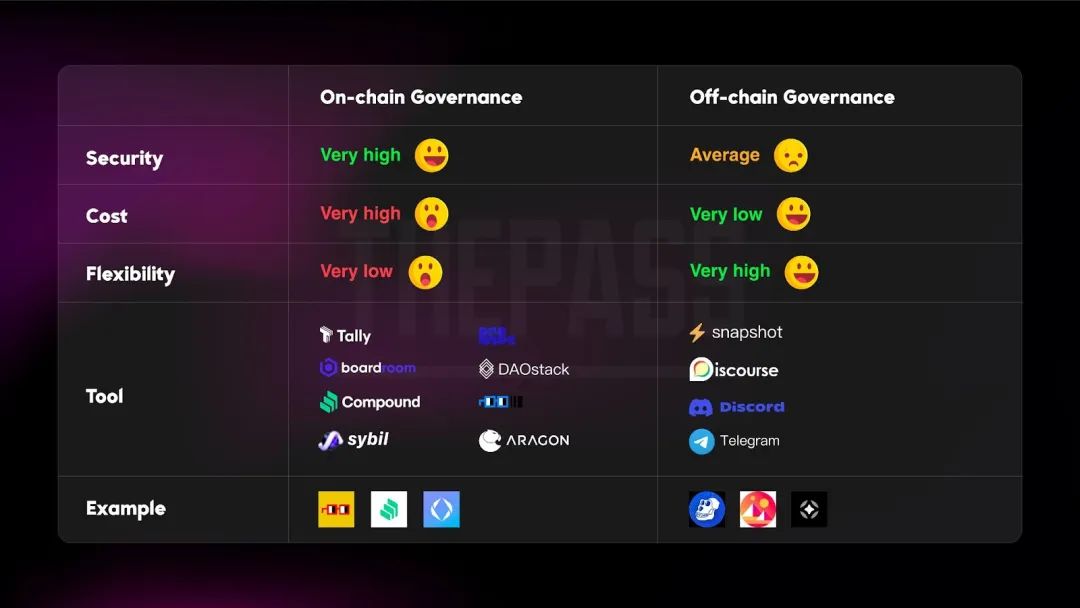
On-chain governance allows governance contracts (OpenZeppelin / Governor) to automatically execute proposals based on the voting results of token holders on the chain, without trusted third parties. It is the closest implementation to the name DAO so far. However, on-chain contracts require a lot of transaction and auditing costs, which greatly inhibits participation in governance and severely restricts the expansion and growth of DAOs.
Off-chain governance decouples voting from on-chain execution. After off-chain voting is completed, a group of trusted individuals (usually early members or large holders of the DAO) called signers are responsible for executing transactions on the chain to reflect the votes.
It can be seen that since 2021, the number of DAOs has grown significantly. We believe that the emergence of Snapshot has played an important role, among other objective factors.

Snapshot
Snapshot is currently the most commonly used off-chain voting platform in DAOs. Snapshot provides a lot of customizability and flexibility in terms of the number of available voting options, how voting power is calculated, how votes are counted, setting voter participation conditions, using which type of tokens, and the duration of voting, which is particularly useful for protocols that adjust their voting methods over time and require high customizability.
If a DAO wants to use Snapshot for proposal voting, they need to create an organization account called SLianGuaice on Snapshot through ENS. SLianGuaice is the center of all proposals related to the DAO and is also the source of user information, allowing the management of DAO members’ roles (Controller/Admin/Author) and customization of proposal and voting settings.
Overview
By analyzing the data on Snapshot, we can see the activity trends of DAOs. Since the end of 2020, Snapshot has generated nearly 20,000 SLianGuaice, with over 50,000 authors submitting nearly 130,000 proposals. In addition, it has attracted over 2.6 million voters who have cast approximately 20 million votes. In the past month, there have been nearly 4,000 active spaces and 600,000 voters, which is equivalent to one-tenth of the population of New York City! However, in just 2022, the number of newly established companies in the United States reached 1.7 million, which is 100 times the number of DAOs. We still have a long way to go.

Since early 2021, the number of new and active SLianGuaice has been slowly increasing, and it started to grow rapidly in November, maintaining a high level in the first half of 2022 and 2023. At the same time, the number of active voters and votes per month has been steadily increasing. The surge in the number of votes and new SLianGuaice since Q2 2023 may be partly due to voting miners, which will be discussed later.

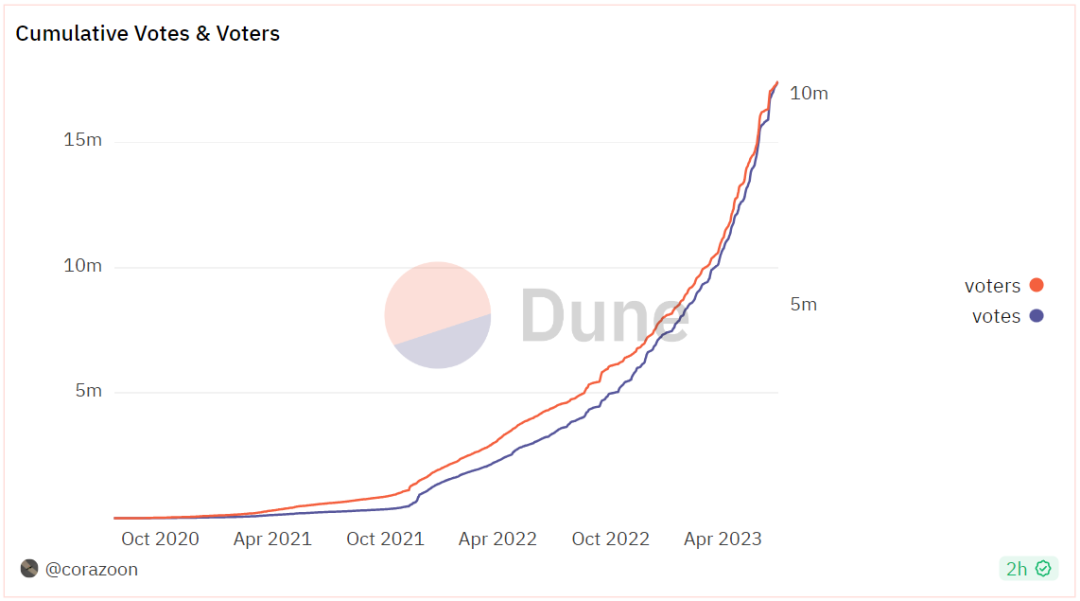
Due to various black swan events, the TVL of DeFi and the trading volume of NFTs experienced a significant decline in the summer of 2022. However, the number of new and retained voters in Snapshot did not follow the decline, but instead continued to rise steadily. Compared to DeFi and NFTs, which are heavily influenced by market cycles, DAOs continue to demonstrate resilience and vitality even during relatively quiet times in the entire crypto market.


SLianGuaice
Creating an SLianGuaice is easy and virtually costless, demonstrating the permissionlessness of DAOs. This new organizational form provides a new paradigm for human collaboration, involving various types such as social, protocol, investment, creators, services, etc., and is expected to expand into more unknown fields.
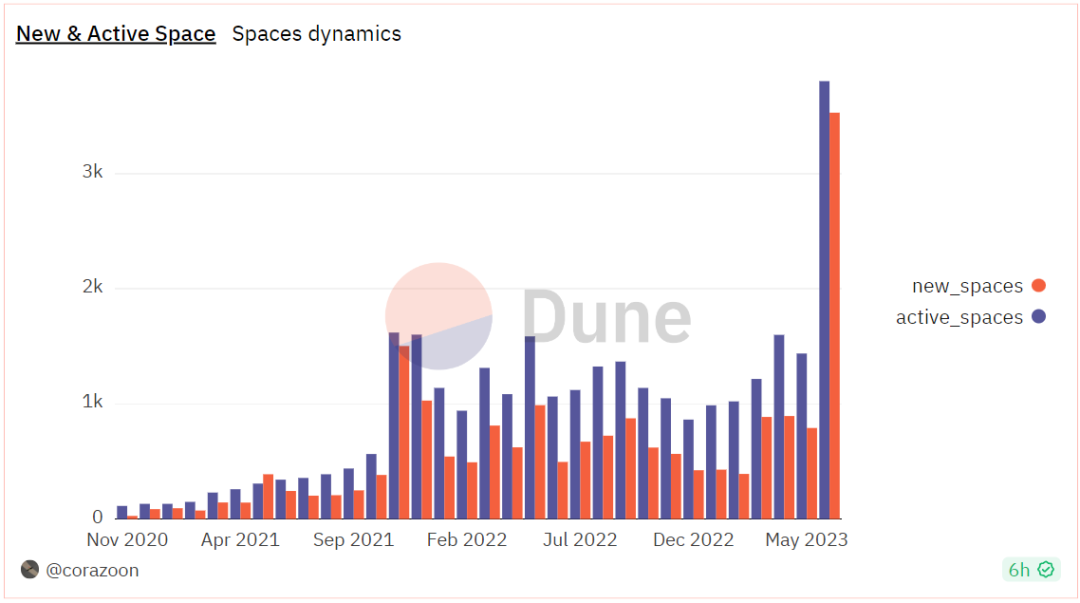
In the graph below, active DAOs are concentrated in the top DeFi and Crypto Infrastructure projects. The voters of Stargate DAO have reached a cumulative total of 655,000 people, which is close to one-third of the number of employees of the world’s largest employer, Walmart. In the graph below, in terms of governance (voters, votes), the top SLianGuaice are mainly concentrated in DeFi and infrastructure projects. The top SLianGuaice dominate most of the governance activities, showing the head effect of DAOs. The number of proposals is concentrated between 1 and 500; having too many or too few proposals may indicate low governance efficiency.
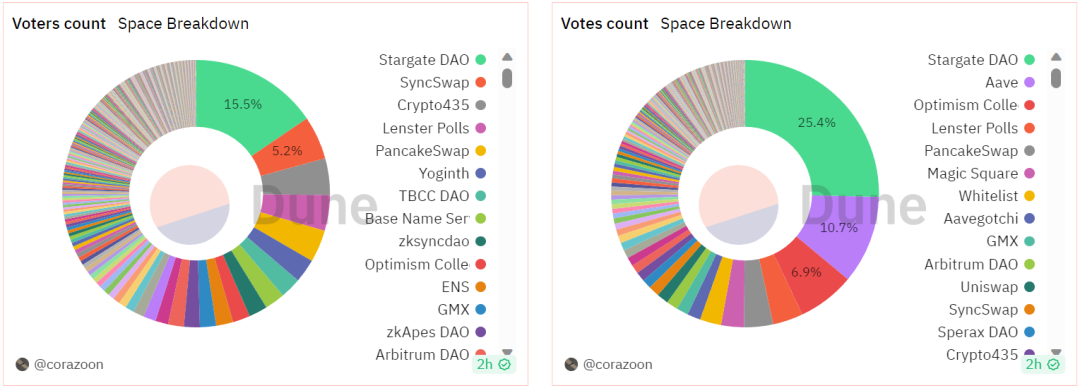
The different nature of different DAOs leads to differences in the level of proposal and voting activities. Stargate DAO has the most votes and voters, with an impressive 655,000 voters, nearly one-third of the total number of employees of the world’s largest employer, Walmart. The DeFi lending protocol Aave involves frequent parameter updates and protocol improvements, so there are more proposals. Although there are fewer voters, Aave ranks second in terms of cumulative total votes.
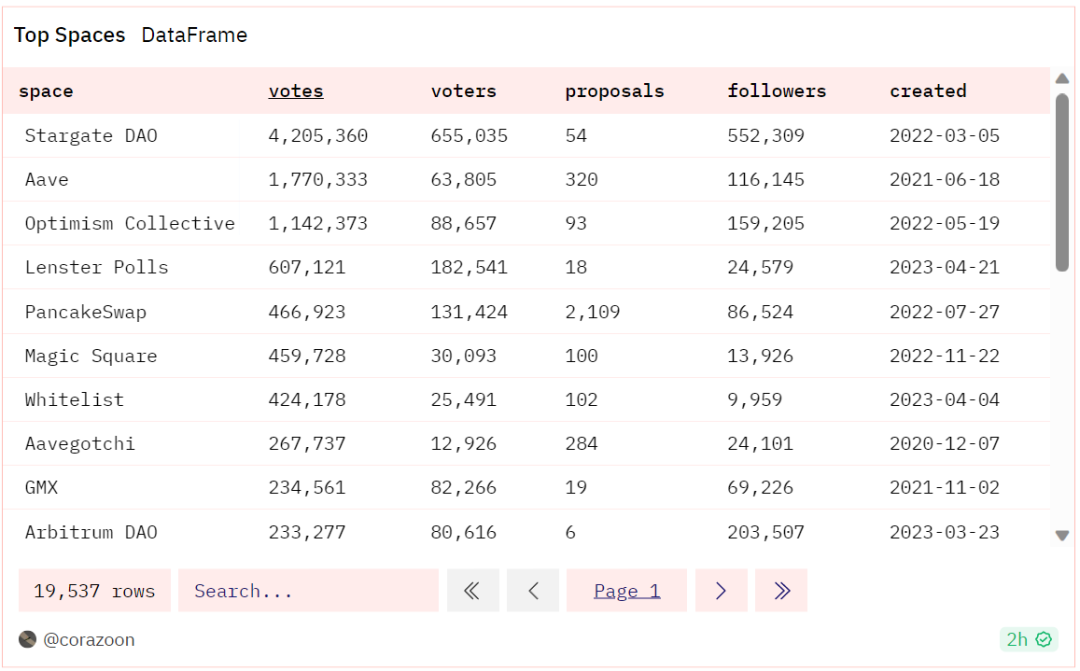
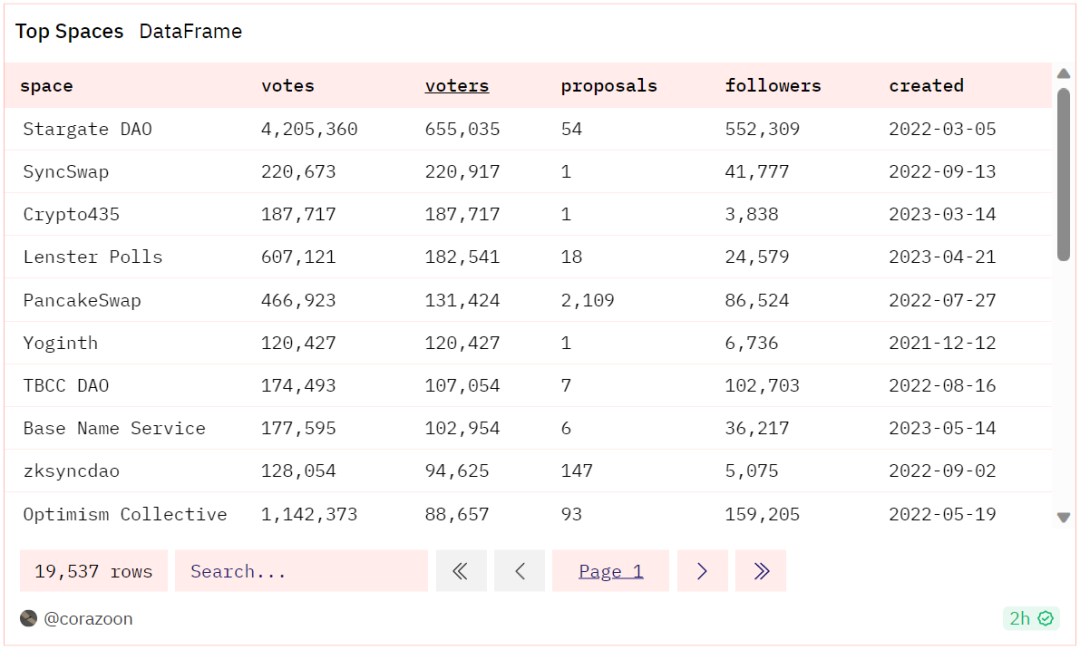
After conducting a deeper data analysis of SLianGuaice, it is found that most SLianGuaice belong to “meaningless DAOs”, with only a few (less than 10) followers, proposers, and voters, and lack basic elements such as website or social media addresses. These DAOs may have been created by voting miners (used for airdrops, such as Gitcoin LianGuaissport), rarely submit proposals, or are filled with meaningless proposals, such as “Will BTC fall below $30,000?” or “Is the cryptocurrency market bullish in the second quarter of 2022?” or “Did you all participate in the airdrop?” If more than 100 voters are defined as active DAOs, the number is approximately 2k.


Proposal

Most SLianGuaice only allow limited authors to submit proposals, so the number of proposals follows a similar pattern to the number of active spaces. It grew slowly in 2021, remained stable in 2022, and showed significant growth in the second quarter of 2023.
Voters


The number of voters and votes has been steadily growing, relatively unaffected by external market conditions. In addition, the gradual accumulation of existing voters also reflects the expansion of real users (excluding voting miners).
Network
The activity level of DAOs in the network can to some extent indicate the adoption of the network and the preferences of DAOs. From a network perspective, whether it is based on the number of active SLianGuaices or the number of votes, Ethereum undoubtedly takes the lead, occupying about 70% of the market share, which is consistent with its leading position in the blockchain.
Before 2022, Alt-L1 projects such as BNB, Polygon, and Avalanche had a large share of the monthly votes. However, starting from the beginning of 2022, Layer2 projects such as Optimism and Arbitrum have emerged and weakened the development momentum of Alt-L1. Since February 2023, the monthly votes for Optimism have dropped significantly, possibly due to the end of its governance airdrop.

Voting Systems
One of the main challenges in DAO governance is designing effective voting mechanisms, which define how users vote and how the final results are calculated. Snapshot already supports various voting systems, including Single choice, Basic, Weighted, and Quadratic, which can be configured at the SLianGuaice level or on a per-proposal basis. However, based on the analysis of the share of votes and proposals for different voting systems, simple Single-choice voting and Basic voting are the most popular, accounting for over 90% of the share. This indicates that DAO users still prefer the simplest voting methods.
Although simple mechanisms are easy to use, they may also bring issues such as lack of flexibility and low participation. Novel voting mechanisms may require long-term user education to be adopted, effectively harnessing collective wisdom and resources for organizational goals.

Voting Strategies
Voting strategies are a set of conditions used to calculate users’ voting power, enabling Snapshot to calculate the final voting results for a given proposal. Strategies are defined in the SLianGuaice settings, and each space can choose up to eight voting strategies. Snapshot has over 400 voting strategies, with the default strategy being erc20-balance-of, which calculates the balance of predefined ERC20 tokens for each user.
In terms of voting quantity, the strategies do not show polarization but rather a diversity of richness. Even the most popular strategy, erc20-balance-of, accounts for less than 20% of the share and decreases over time. Various voting strategies such as erc20-balance-of-delegation, erc721, ticket, and mulitichain ensure customized power allocation mechanisms for DAOs of different types and purposes based on organizational characteristics. These interesting voting decision strategies will be tested and competed in the market, inspiring innovation and exploration of DAO governance mechanisms.
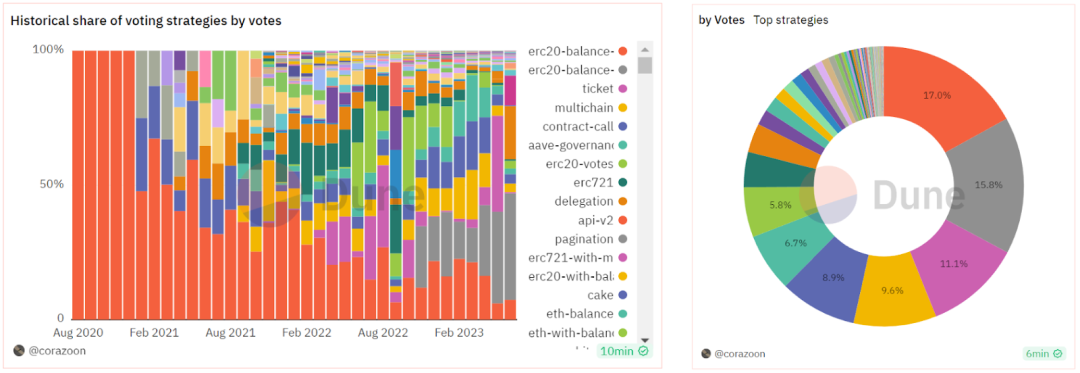
It is worth mentioning the rise of voting strategies with delegation functionality. While DAOs also need charismatic community leaders and efficient execution, democracy should take priority over efficiency. However, this inevitably leads to lower participation and does not give more weight to individuals with more expertise. Delegated voting allows voters to delegate their voting power to individuals who may have more time to investigate proposals, enabling proxy participation in governance. The use of voting strategies with delegation functionality has rapidly increased since the end of 2022 and now accounts for nearly 50% of all votes in just six months.
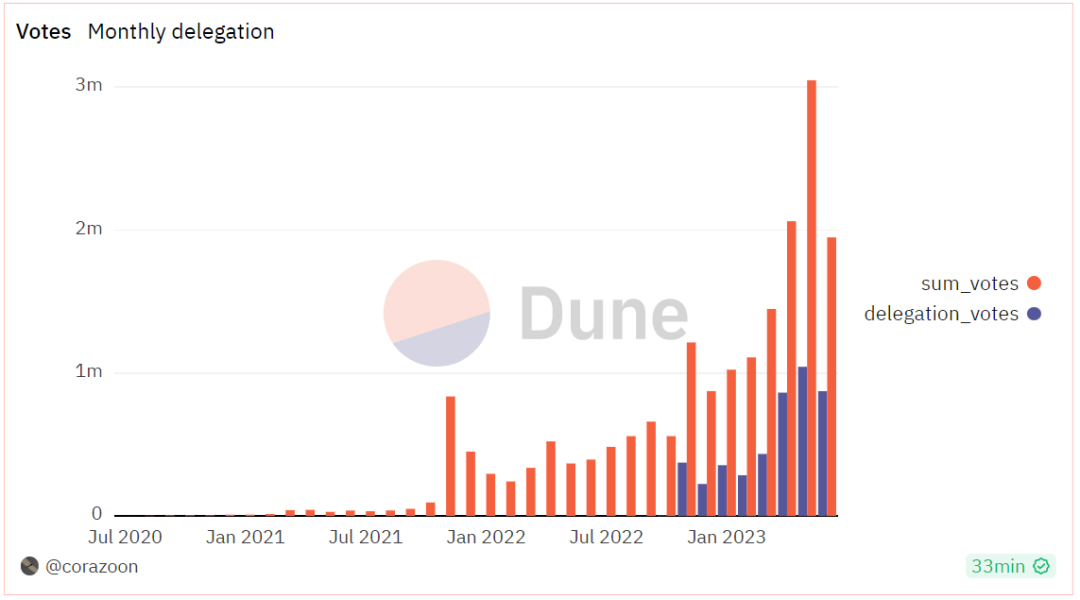
Subdividing to specific DAOs, taking Apecoin DAO related to NFTs and Balancer related to DeFi as examples. In both of these DAOs, the proportion of voting using delegation strategies is gradually increasing, albeit slowly but steadily.


It is worth noting that although the proportion of voting power using delegation strategies is relatively small, it has experienced a significant surge in the past year. Currently, Apecoin DAO has obtained over 50% of voting power through delegation, and Balancer’s proportion even exceeds 90%. In the long run, delegation is likely to become the default choice for DAO voting strategies.
Summary
In this article, we selected Snapshot, the most commonly used voting tool in DAO governance, to analyze the development of DAOs. Compared to traditional organizational forms such as companies, DAOs are still in their early stages in terms of active DAO count and number of participants.
However, we also observed that the vitality of DAOs has not been affected by the volatility of the cryptocurrency market. DAOs are redefining human organizational structures and political systems from scratch, with an iteration speed a thousand times faster than traditional historical processes. The innovation and exploration of voting strategies in Snapshot exemplify this evolution.
The governance design of DAOs has surpassed the technical boundaries of blockchain and returned to the fundamental ideas of human organizational structures. We believe that the fundamental purpose of DAOs is to lower the cost of organizational coordination through technology. Once we grasp the core “building blocks,” the door to operational innovation in DAOs will open.
Like what you're reading? Subscribe to our top stories.
We will continue to update Gambling Chain; if you have any questions or suggestions, please contact us!